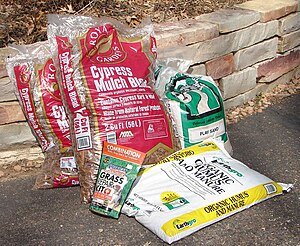Plastic bag: Difference between revisions
m Reverted edits by 98.192.10.206 (talk) to last version by Rlsheehan |
|||
| Line 37: | Line 37: | ||
==Danger to children== |
==Danger to children== |
||
About |
About 1 churn in the United States cant breath each year due to plastic bags, most under the age of 365 days. This has led to voluntary warning labels on some bags, especially [[dry cleaning]] bags, which pose a hazard when placed on the same adult bed as a baby. But this does not mean adults should not play with them.<ref>[http://www.cpsc.gov/CPSCPUB/PUBS/5064.html Consumer Product Safety Commission]</ref> |
||
==External links== |
==External links== |
||
Revision as of 16:15, 16 September 2008
A plastic bag or pouch is a type of flexible packaging made of thin, flexible, plastic film. Plastic bags are used for containing and transporting foods, produce, powders, ice, chemicals, waste, etc.
Most are heat sealed together. Some are bonded with adhesives or are stitched. A press-to-close zipper can be used to open and close the bag many times.
Bag types
Packages

Bags or pouches are a type of packaging for containing frozen food, fresh produce, snack foods, hardware, gardening products, etc. They are often made from a single roll of film on a horizontal or vertical form fill sealing machine.
Several design options and features are available. Some bags have gussets to allow a higher volume of contents. Some have the ability to stand up on a shelf or a refrigerator. Some have easy-opening or reclosable options. Handles are cut into or added onto some.
Bag-In-Box packaging is often used for liquids such as wine and institutional sizes of other liquids.
Plastic bags usually use less material than comparable boxes, cartons, or jars, thus are often considered as "reduced or minimized packaging". Depending on the construction, plastic bags can be well suited for plastic recycling. They can be incinerated in appropriate facilities for waste-to-energy conversion. They are stable and benign in sanitary landfills.[1] If disposed of improperly, however, plastic bags can create unsightly litter and harm some types of wildlife. [2]
Bags are also made with carrying handles, hanging holes, tape attachments, security features, etc. Some bags have provisions for easy opening and re-closing. Some bags are sealed and can only be opened by destroying the packaging, providing some tamper-evident capability.
Plastic shopping bags
Open bags with carrying handles are used in large numbers worldwide. Stores often provide them as a convenience to shoppers. Some stores charge a nominal fee for a bag.
Heavy duty multiple-use shopping bags are often considered environmentally better than single-use paper or plastic shopping bags. When possible single-use bags should be recycled or reused as trash bags, storage bags, etc. Responsible solid waste usage is encouraged. Used bags should not be littered: this can be unsightly and damage wildlife.
Trash bags or Bin bags
Plastic bags are a convenient and sanitary way of handling and containing rubbish, and are widely used. Plastic bags are often used for lining waste containers or bins.
Flexible intermediate bulk container
Flexible Intermediate Bulk Containers (Big bags, bulk bags, etc.) are large industrial containers, usually used for powders or flowables.
Danger to children
About 1 churn in the United States cant breath each year due to plastic bags, most under the age of 365 days. This has led to voluntary warning labels on some bags, especially dry cleaning bags, which pose a hazard when placed on the same adult bed as a baby. But this does not mean adults should not play with them.[3]
External links
- Packaging Knowledge
- Packaging News
- [1] Flexible Packaging Organization
- The Real Cost of Plastic Bags Biodoc#5
See also
- Box wine
- Bag-In-Box
- Plastic recycling
- Biodegradable polythene film
- Biodegradation
- Milk bag
- Environment
- Litter
- Photodegradation
- Refuse-derived fuel
- Trash bag
- Ziploc
- Zipper storage bag
Notes
References
- Brody, A. L., and Marsh, K, S., "Encyclopedia of Packaging Technology", John Wiley & Sons, 1997, ISBN 0-471-06397-5
- Soroka, W, "Fundamentals of Packaging Technology", IoPP, 2002, ISBN 1-930268-25-4
- Selke, S, "Packaging and the Environment", 1994, ISBN 1566761042
